The world economy was hit by a string of seismic shocks in 2022 as it got close to meeting the halfway point for the 2030 Sustainable Development Goals laid out by the United Nations. They included the global effects of COVID-19, the invasion of Ukraine, the oil and gas crisis in Europe, and the deepening malnutrition and famine in many developing nations.
Investors’ ever-going pursuit of the next big thing has always been the one constant in the dynamic world of investment. From a macro perspective, that search has always stopped in China, at least for the last 2 decades. But, the extraordinary nature of China’s economic growth prompted a fundamental reevaluation of our perspective on the world economy. While the US and China will continue to be crucial for international investors during the coming ten years, investors’ attention will be drawn more and more to India as its economy grows.
With its economy opening and expanding more and more, India, the world’s sixth-largest economy, has contributed about $1.3 trillion to global demand over the past ten years [1]. Notwithstanding the fact that the advanced economies receive 50% of India’s exports, the country will be more domestically than internationally focused in the decade. Witnessing substantial growth in the private sector, faster credit cycles, and growing share of investment in the GDP, the Indian economy is giving new dimensions to investor profitability.
These are the circumstances that, in any economy, inspire trust in investors that their investments are parked at a haven and that ROIs are about to take a good upswing.

In this blog, we touch upon 5 indicators highlighting India’s mark on the world economy.
High Resilience to External Factors
India’s economy has demonstrated to be exceptionally resilient to the detrimental external environment, in contrast to other developing market nations, due to solid macroeconomic fundamentals. The World Bank increased its 2022–23 GDP prediction from 6.5% (in October 2022) to 6.9% in light of India’s good performance in the second quarter (July–September) of the fiscal year 2022–23 [2].
These predictions are supported by a host of positive domestic and international influences. The most significant domestic change is the change in the focus of policy from redistribution to promoting investment and job development. The implementation of the goods and services tax (GST) which unifies its domestic market, corporate tax cuts, and production-linked programmes encouraging investments from both within and outside of India’s borders are clear examples of this. The advent of a multipolar world, where businesses are diversifying their supply chains with India rising as a preferred investment location, is a factor that is overlaid by this.
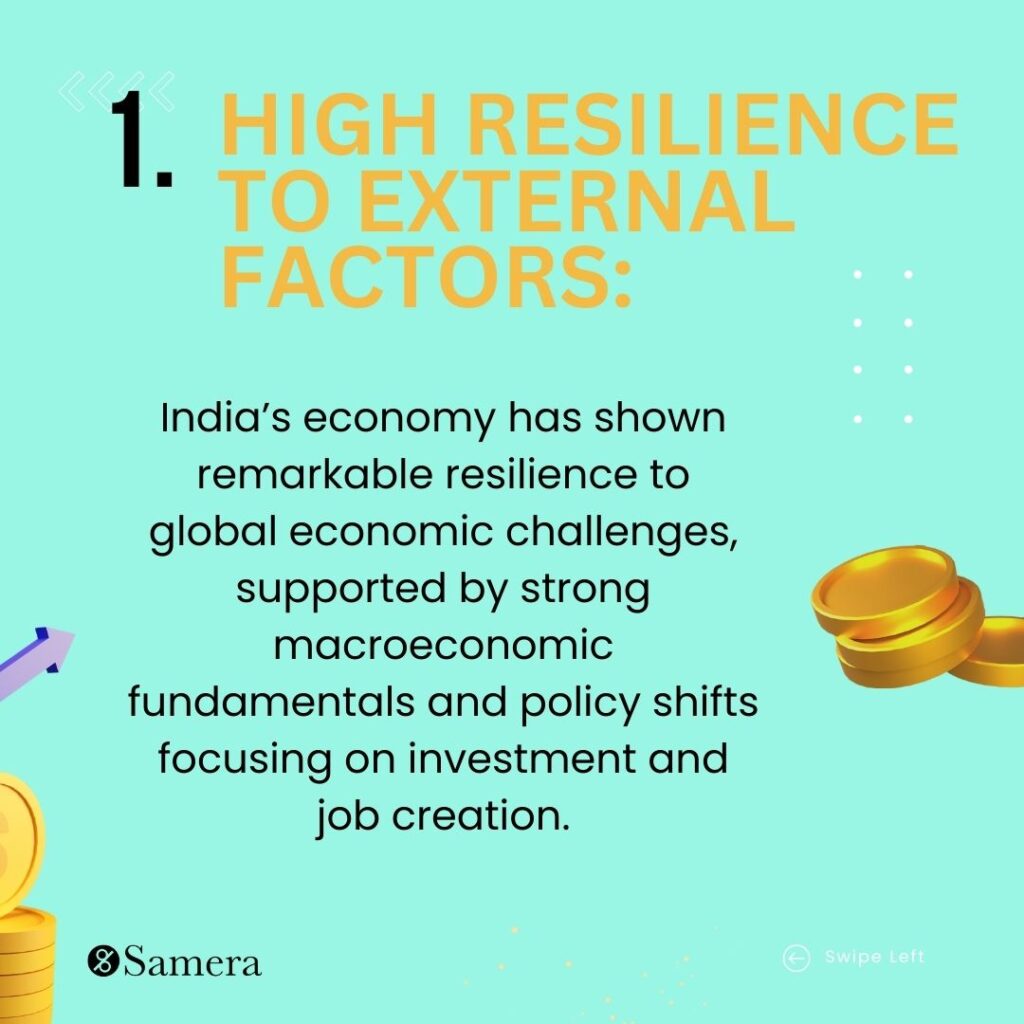
Resistance to Macroeconomic Spillovers
In comparison to other emerging countries, the economy of India is comparatively protected from global spillovers. Out of all the macroeconomic indicators, the steady development of the GST has provided the cause for India’s promise of global development another gear. Not only was there growth every month of this fiscal year but there was also monthly absolute growth of more than Rs. 1.4 lakh crore over a period of ten months [3].
India’s enormous domestic market and relative lack of exposure to international trade flows are partially responsible for this. While a 1 percentage point reduction in US growth relates to a 0.4 percentage point decline in India’s GDP, the effect is roughly 1.5 times bigger for other emerging countries, according to the World Bank’s “Navigating the Storm” report [4].
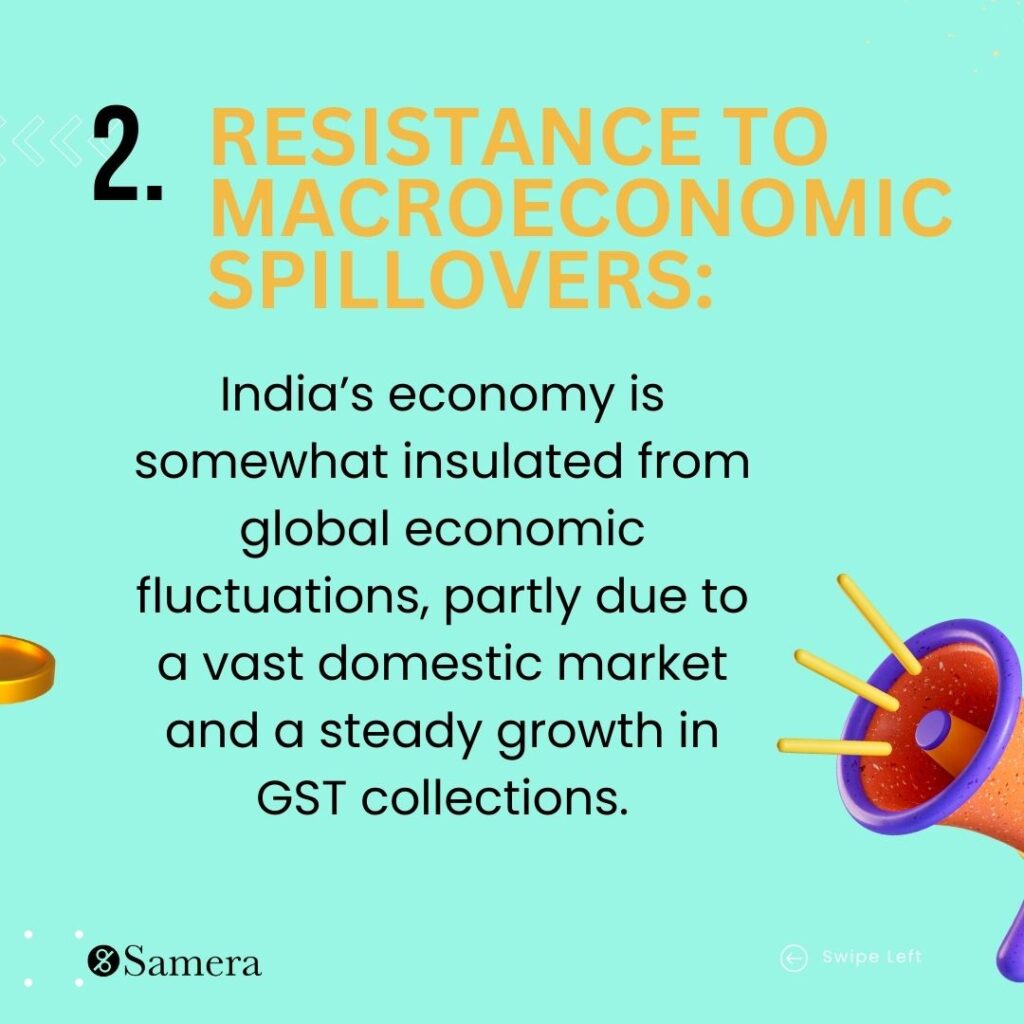
Rising Global Contribution to Exports
In 2022, India saw a remarkable 14.6% YoY increase in exports, valuing a total of USD 453.3 billion [5].
India exports a fair proportion of both goods and services. Additionally, the shift in export direction indicates that India has been diversifying the final destinations for its exports away from conventional ones. A favorable exchange rate, affordable finance, and relatively modest wages helped this method achieve a competitive edge.
This growth strategy received support from the global demand for goods, notably in the developed markets. India’s significant market share means that it may compare its performance to international norms, making it worthwhile to pursue on its own. The economy is more resilient to changes in global demand thanks to the double thrust of domestic and export demand, which is another indicator of a positive economic outlook.
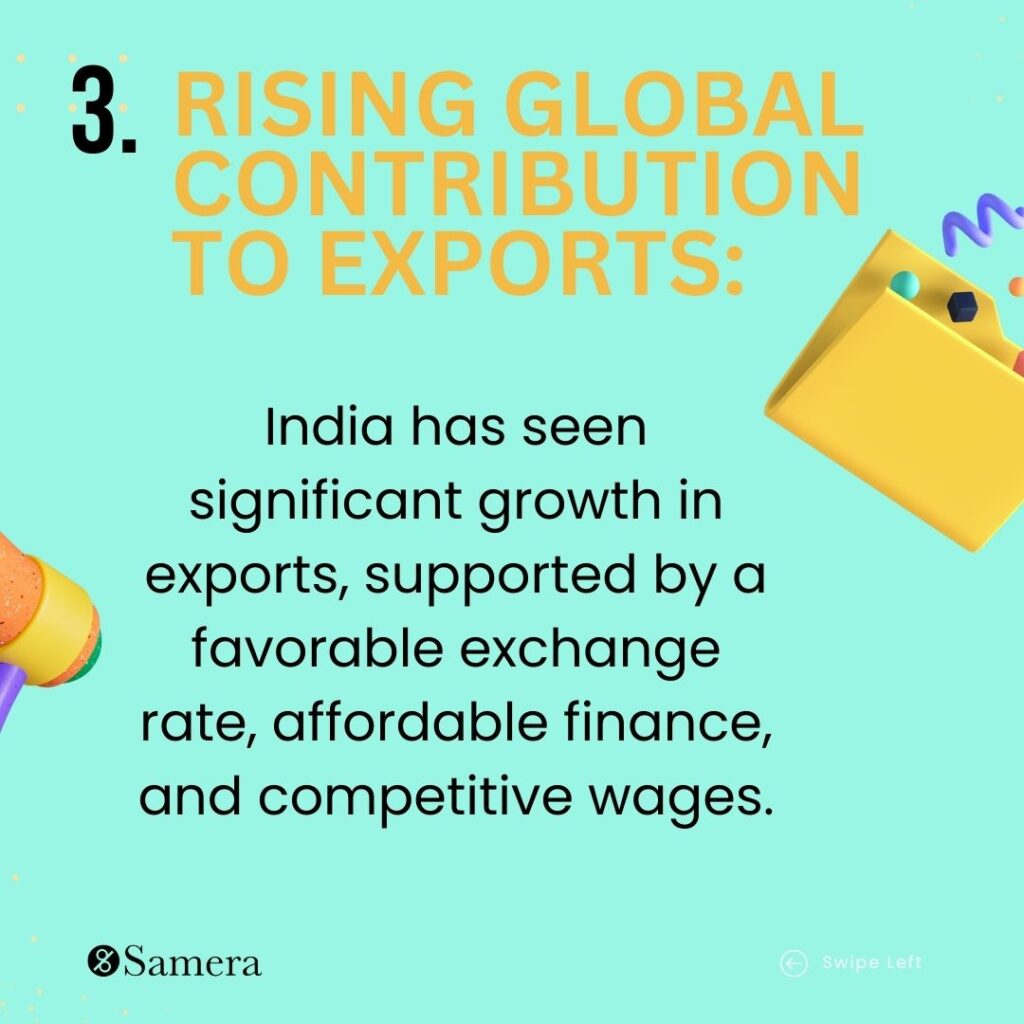
Acceleration Towards Energy Independence
Over the last 8.5 years, India’s installed renewable energy capacity has grown by 396%, reaching more than 174.53 Giga Watts (including big Hydro), or around 42.5% of the nation’s overall capacity (as of February 2023). In 2022, India experienced the biggest year-over-year growth in the addition of renewable energy, at 9.83%.
These projects are also investment magnets and unlock potential for great returns while supporting country-wide renewable projects, which include setting up 100 smart cities, 100,000 solar pumps in farms, and a 12,600km-wide green energy corridor to better connect electric vehicles on the move [6].
India is the third-largest energy consumer in the world and ranks third in the attractiveness of renewable energy countries rating for 2021. With lucrative investment prospects for foreign investors, the nation is quickly moving towards energy independence. A crucial step in this process is enabling 100% FDI in the production and distribution of renewable energy, enabling the country to draw INR 1.5–2 trillion in foreign direct investments annually [7].
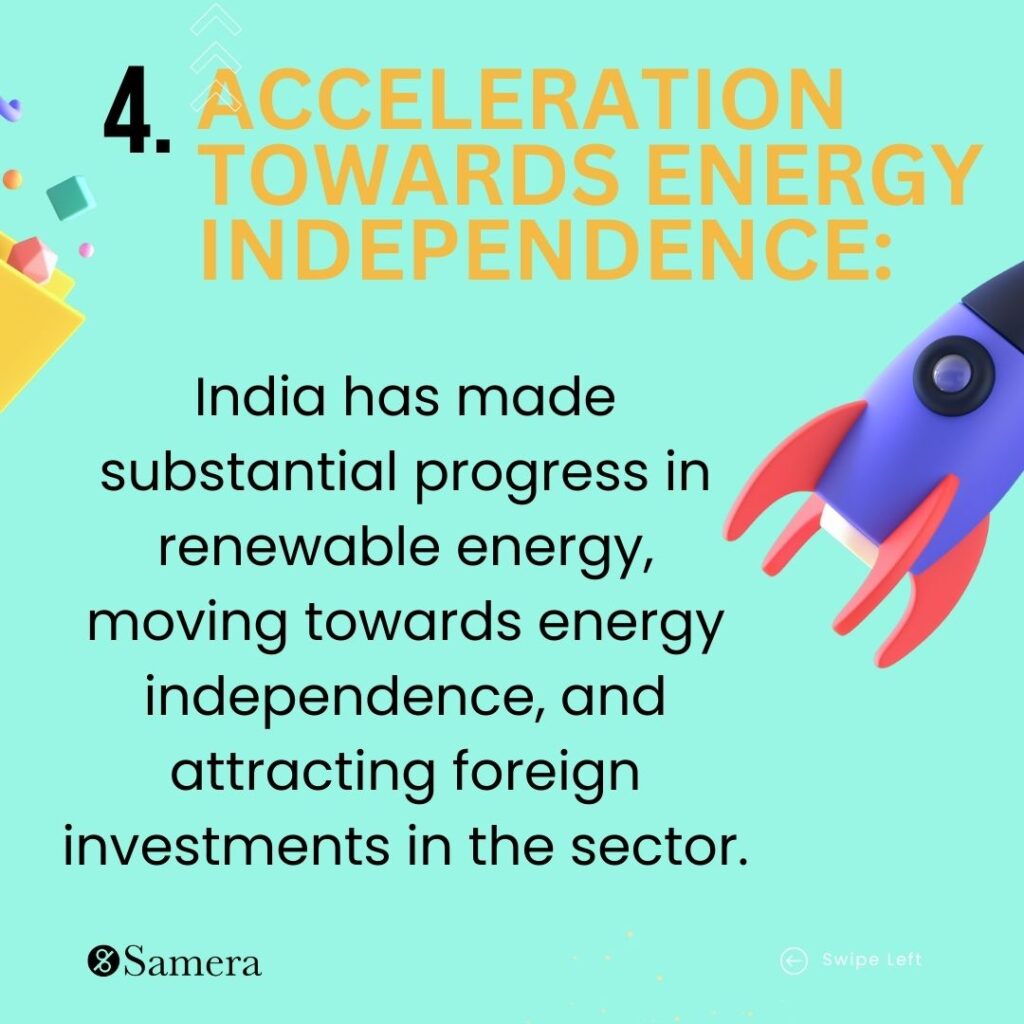
For more information read our article on Top 5 Accounting Outsourcing firms to future-proof your financial success.
Investor-First Regulatory Framework
Pragmatic regulatory improvements and policy alterations have also substantially aided the growth of India’s economy. The government has widened the investor base for sovereign bonds and increased the openness and credibility of fiscal policy as a result of the increased reliance on market borrowings. Throughout the previous ten years, a formal framework for targeting inflation was introduced, which was a crucial step in establishing the legitimacy of monetary policy actions.
The implementation of several regulatory and policy measures, such as the National Reconstruction Company Limited and the adoption of the Bankruptcy and Insolvency Code, have enabled improved KPIs in India’s financial sector over the previous decade.
Moreover, it is predicted that these regulatory changes would lessen pressures brought on by non-performing assets or NPAs. A reliable early indication of economic performance is loan growth. Credit has also rebounded in these years, contributing to the expansion of the combined balance sheets of Indian banks, according to the Trend and Development of Banking, 2021–22 Report published by the Reserve Bank of India, the county’s central bank [8].
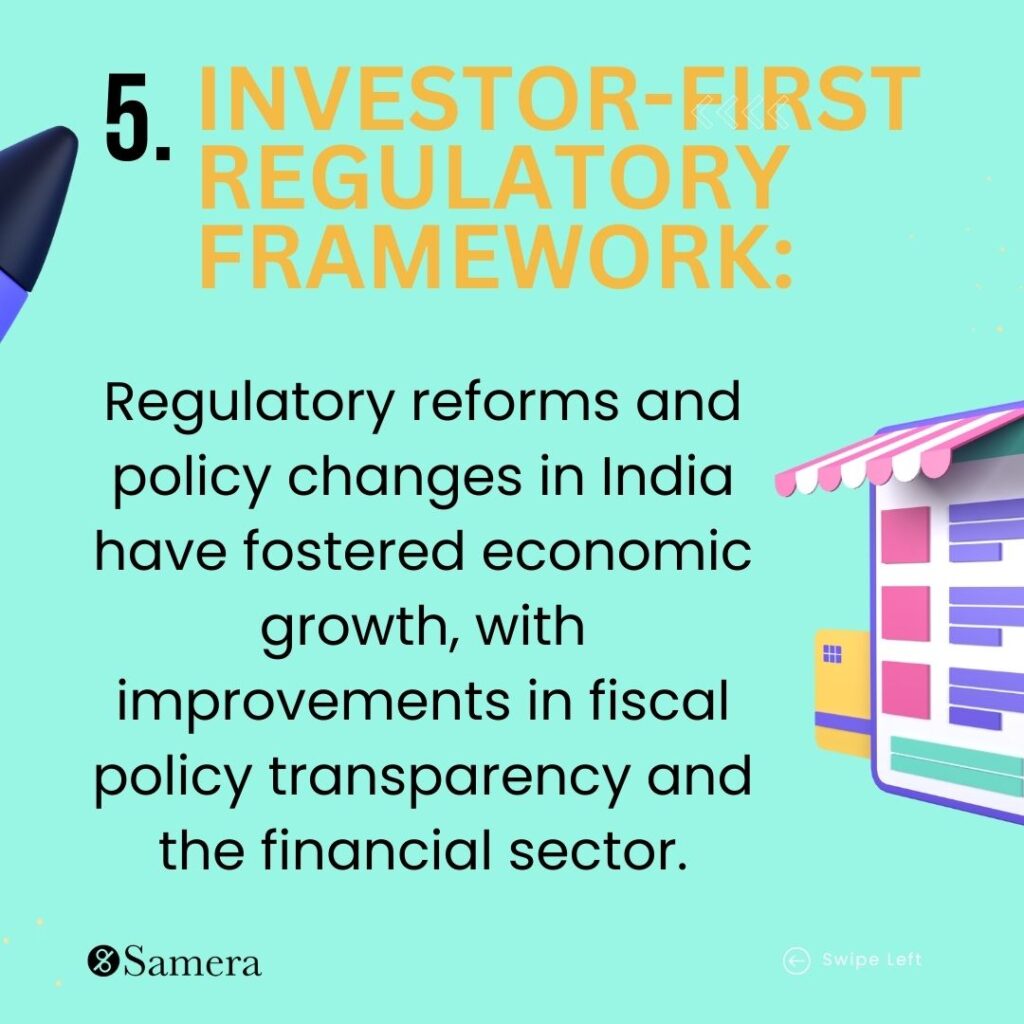
Did You Know?
- India is the world’s fastest-growing major economy, with a projected GDP growth rate of 7.2% in 2023-24. (Source: International Monetary Fund)
- India has a young and growing workforce, with over 62% of the population under the age of 35. (Source: World Bank)
- India is a major player in the global digital economy, with over 800 million internet users. (Source: Internet and Mobile Association of India)
- India is the world’s third-largest startup ecosystem, with over 70 unicorns and a total valuation of over $300 billion. (Source: Hurun India Unicorn Index 2023)
- India is attracting record levels of foreign direct investment, with over $83 billion invested in the financial year 2022-23. (Source: Department for Promotion of Industry and Internal Trade)
Conclusion
India is growing as an exporter and importer of commodities, services, and financial flows in addition to its participation in the global economic and financial systems. As opposed to the previous decade, this one has seen these cross-border flows develop into a significant sector of the Indian economy.
India’s rapidly expanding regional footprint will expand into a global one thanks to these 5 indicators. India already commands a substantial portion of the global services export market, and since the pandemic’s start, this advantage has grown. India appears to be well-positioned to address important global concerns and unlock a sustainable investment avenue for the international community in the upcoming ten years.

Bibliography
- https://economictimes.indiatimes.com/markets/expert-view/india-a-much-more-important-force-of-global-economic-growth-vs-european-countries-jim-walker/articleshow/97935329.cms
- https://documents1.worldbank.org/curated/en/099143112052224154/pdf/IDU0d4ad74a108a3304f93083990163996425f3a.pdf
- https://www.thehindu.com/business/Economy/watch-business-matters-what-do-macro-economic-indicators-tell-us-about-indias-performance/article66342164.ece
- https://documents1.worldbank.org/curated/en/099143112052224154/pdf/IDU0d4ad74a108a3304f93083990163996425f3a.pdf
- https://economictimes.indiatimes.com/news/economy/indicators/indias-exports-rise-in-both-value-volume-terms-in-2022-gtri-report/articleshow/97980144.cms
- https://www.investindia.gov.in/sector/renewable-energy
- https://www.investindia.gov.in/sector/renewable-energy
- https://www.thehindu.com/business/Economy/watch-business-matters-what-do-macro-economic-indicators-tell-us-about-indias-performance/article66342164.ece
Reviewed By:

Arun Mehra
Samera CEO
Arun, CEO of Samera, is an experienced accountant and dental practice owner. He specialises in accountancy, financial directorship, squat practices and practice management.




